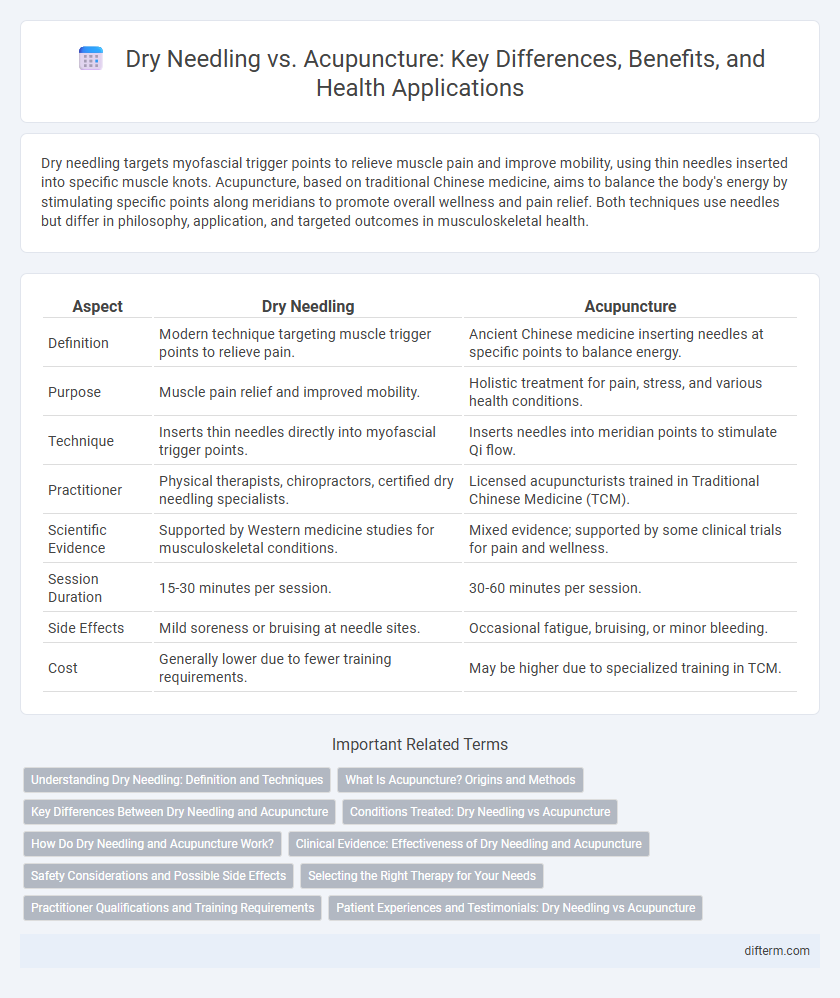Dry needling targets myofascial trigger points to relieve muscle pain and improve mobility, using thin needles inserted into specific muscle knots. Acupuncture, based on traditional Chinese medicine, aims to balance the body's energy by stimulating specific points along meridians to promote overall wellness and pain relief. Both techniques use needles but differ in philosophy, application, and targeted outcomes in musculoskeletal health.
Table of Comparison
| Aspect | Dry Needling | Acupuncture |
|---|---|---|
| Definition | Modern technique targeting muscle trigger points to relieve pain. | Ancient Chinese medicine inserting needles at specific points to balance energy. |
| Purpose | Muscle pain relief and improved mobility. | Holistic treatment for pain, stress, and various health conditions. |
| Technique | Inserts thin needles directly into myofascial trigger points. | Inserts needles into meridian points to stimulate Qi flow. |
| Practitioner | Physical therapists, chiropractors, certified dry needling specialists. | Licensed acupuncturists trained in Traditional Chinese Medicine (TCM). |
| Scientific Evidence | Supported by Western medicine studies for musculoskeletal conditions. | Mixed evidence; supported by some clinical trials for pain and wellness. |
| Session Duration | 15-30 minutes per session. | 30-60 minutes per session. |
| Side Effects | Mild soreness or bruising at needle sites. | Occasional fatigue, bruising, or minor bleeding. |
| Cost | Generally lower due to fewer training requirements. | May be higher due to specialized training in TCM. |
Understanding Dry Needling: Definition and Techniques
Dry needling is a therapeutic technique used primarily by physical therapists to treat musculoskeletal pain by inserting thin needles into trigger points or tight muscle bands. Unlike acupuncture, which is based on traditional Chinese medicine and energy flow, dry needling targets specific myofascial tissue to release muscle tension and improve function. The technique involves precise needle placement to stimulate muscle relaxation and promote blood flow, aiding in pain relief and recovery.
What Is Acupuncture? Origins and Methods
Acupuncture is a traditional Chinese medicine technique that involves inserting fine needles into specific points on the body to stimulate energy flow and promote healing. Originating over 2,500 years ago, it is based on the concept of balancing the body's Qi, or vital energy, through meridians. Common methods include manual needle manipulation and electrical stimulation to alleviate pain, reduce inflammation, and improve overall health.
Key Differences Between Dry Needling and Acupuncture
Dry needling targets myofascial trigger points to relieve muscle pain and improve function, often performed by physical therapists. Acupuncture, rooted in traditional Chinese medicine, involves inserting needles at specific meridian points to balance energy flow and promote overall wellness. The primary difference lies in their theoretical foundations and treatment goals, with dry needling focusing on musculoskeletal conditions and acupuncture addressing broader holistic health issues.
Conditions Treated: Dry Needling vs Acupuncture
Dry needling primarily targets musculoskeletal conditions such as myofascial pain syndrome, muscle tightness, and trigger points to alleviate pain and improve mobility. Acupuncture addresses a broader range of conditions, including chronic pain, migraines, digestive issues, and stress-related disorders by stimulating specific meridian points. Both therapies offer complementary approaches but differ in their underlying principles and therapeutic goals.
How Do Dry Needling and Acupuncture Work?
Dry needling targets myofascial trigger points by inserting thin needles directly into muscle knots to relieve pain and improve movement. Acupuncture stimulates specific meridian points along the body to balance energy flow (Qi) and promote natural healing processes. Both therapies use needles but differ in underlying principles and treatment goals, with dry needling focusing on musculoskeletal conditions and acupuncture on holistic wellness.
Clinical Evidence: Effectiveness of Dry Needling and Acupuncture
Clinical evidence indicates that dry needling effectively reduces musculoskeletal pain and improves function by targeting myofascial trigger points, supported by multiple randomized controlled trials. Acupuncture demonstrates benefits in managing chronic pain conditions, such as osteoarthritis and tension headaches, through neuromodulation and endogenous opioid activation documented in systematic reviews. Comparative studies suggest both modalities offer pain relief, but dry needling primarily addresses muscular dysfunction while acupuncture provides broader effects on systemic health.
Safety Considerations and Possible Side Effects
Dry needling and acupuncture both involve inserting fine needles into the skin but differ in technique and safety profiles. Dry needling primarily targets myofascial trigger points and may cause soreness, bruising, or minor bleeding, while acupuncture, rooted in traditional Chinese medicine, aims to balance energy flow with side effects typically including mild pain, fatigue, or dizziness. Both therapies require trained practitioners to minimize risks such as infection or nerve injury, emphasizing the importance of sterile needles and proper technique for patient safety.
Selecting the Right Therapy for Your Needs
Dry needling targets myofascial trigger points to relieve muscle pain and improve mobility, making it ideal for musculoskeletal issues like sports injuries and chronic pain. Acupuncture stimulates specific points along energy meridians to balance the body's Qi, beneficial for holistic health concerns such as stress, digestive problems, and overall wellness. Choosing between dry needling and acupuncture depends on your specific condition, treatment goals, and whether you prefer a Western medical or traditional Chinese medicine approach.
Practitioner Qualifications and Training Requirements
Dry needling practitioners typically require certification in physical therapy or a related healthcare field, with specialized training involving anatomy, neuromuscular assessment, and needle safety. Acupuncturists must complete extensive education in Traditional Chinese Medicine, often spanning 3 to 4 years, including clinical internships and licensing exams regulated by state or national boards. Both professions emphasize rigorous training, but acupuncture involves a broader holistic approach while dry needling focuses primarily on musculoskeletal conditions.
Patient Experiences and Testimonials: Dry Needling vs Acupuncture
Patients report that dry needling often provides quicker relief from muscle pain and tension, particularly in cases of sports injuries or myofascial pain syndrome. Acupuncture users highlight benefits related to overall wellness, stress reduction, and chronic pain management, emphasizing a more holistic approach. Testimonials suggest dry needling targets specific trigger points with precision, while acupuncture offers broader therapeutic effects through traditional Chinese medicine principles.
Dry Needling vs Acupuncture Infographic

 difterm.com
difterm.com